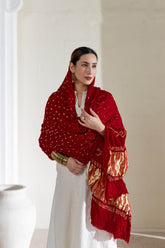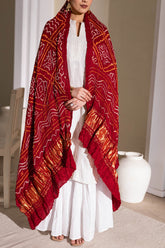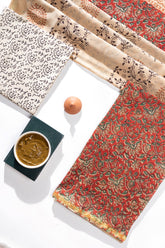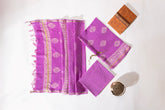Introduction : The Timeless Allure of Maheshwari Sarees
Maheshwari sarees are more than just elegant attire—they are a living testament to India’s rich textile heritage, royal patronage, and the visionary leadership of Queen Ahilya Bai Holkar. From their origins in the heart of Madhya Pradesh to their enduring status as a symbol of grace and tradition, the history of Maheshwari sarees is woven with stories of craftsmanship, culture, and royal legacy.
Maheshwari Saree History-A Royal Beginning
The roots of Maheshwari sarees stretch back to the 18th century, when Queen Ahilya Bai Holkar of the Holkar dynasty envisioned a saree that reflected both regal splendor and practical comfort. Inspired by the intricate carvings of Maheshwar Fort and the temples along the Narmada River, she brought together master weavers from Surat and Mandu to bring her vision to life.
Origin of Maheshwari Sarees:
· Birthplace: Maheshwar, Madhya Pradesh, on the banks of the Narmada River.
· Early Purpose: Designed as royal gifts for palace guests and dignitaries.
· Initial Name: Garbh Reshmi sarees, crafted from a blend of silk and cotton for comfort and elegance.
Queen Ahilya Bai’s Influence:
· She personally oversaw the design process, ensuring motifs and patterns echoed the region’s architectural beauty.
· Her patronage transformed Maheshwar into a thriving hub for handloom weavers, fostering economic growth and cultural pride.
Traditional Maheshwari Sarees Origin and Heritage
Maheshwar Saree Heritage
The heritage of Maheshwari sarees is deeply intertwined with the cultural and economic history of Maheshwar. The town’s strategic location along the Narmada River made it a center for trade, attracting artisans and traders from across India.
Historical Timeline:
· 5th Century: Early weaving traditions established in Maheshwar.
· 17th Century: Maheshwar emerges as a prominent handloom center.
· 18th Century: Queen Ahilya Bai’s reign marks the golden era of Maheshwari textiles.
Holkar Dynasty Textiles:
· The Holkar dynasty’s support elevated Maheshwari sarees to the status of royal Indian sarees, worn by nobility and gifted to esteemed visitors.
Authentic Maheshwari Saree Craftsmanship Story
The story of authentic Maheshwari saree craftsmanship is one of meticulous skill, traditional handloom methods, and generational artistry.
Traditional Weaving Methods:
· Maheshwari sarees are handwoven using ancient techniques passed down through families.
· Weavers use a silk-cotton blend, making the sarees lightweight and ideal for India’s climate.
· The weaving process incorporates reversible borders (bugdi), a hallmark of Maheshwari design.
Unique Selling Points:
· Materials: Premium silk and cotton, ensuring both luxury and comfort.
· Craftsmanship: Each saree is a product of weeks of skilled handloom weaving.
· Motifs: Designs are inspired by the Maheshwar fort’s architecture—such as chatai (mat), eent (brick), and heera (diamond) patterns.
· Exclusivity: Each piece is unique, reflecting the artisan’s interpretation of traditional motifs.
Traditional Maheshwari Saree Weaving Techniques
Traditional Handloom Maheshwari Saree Making Process
Step-by-Step Overview:
· Yarn Preparation: Silk and cotton threads are carefully selected and dyed using eco-friendly methods.
· Warping and Wefting: Threads are arranged on the loom, with the warp (lengthwise threads) and weft (crosswise threads) meticulously aligned.
· Weaving: Skilled artisans operate handlooms, interlacing threads to create the saree’s body, border, and pallu.
· Motif Integration: Traditional motifs—often geometric or inspired by local flora and architecture—are woven into the fabric using ancient techniques.
· Finishing: The saree is washed, starched, and checked for quality before being made available for sale.
Ancient Maheshwari Saree Patterns and Their Meaning:
· Chatai: Symbolizes unity and strength.
· Eent: Represents stability and foundation.
· Heera: Signifies prosperity and brilliance.
· Narmada Leher (waves): Pays homage to the Narmada River, the lifeline of Maheshwar.
Cultural Significance of Maheshwari Sarees in Indian History
Maheshwari sarees are not just garments—they are cultural artifacts that reflect the social, economic, and spiritual life of their region.
Cultural Textile Heritage:
· Worn during festivals, weddings, and important ceremonies, Maheshwari sarees symbolize grace, tradition, and the enduring legacy of Indian handloom.
· They are part of royal saree collections and are considered a status symbol among classical Indian textiles.
Handloom Revival Stories:
· The resurgence of interest in handloom sarees has led to renewed appreciation for Maheshwari weavers, supporting rural livelihoods and preserving heritage textile crafts.
Queen Ahilya Bai’s Contribution to Maheshwari Textiles
Queen Ahilya Bai’s legacy is inseparable from the Maheshwari saree’s history.
Visionary Leadership:
· She recognized the potential of local artisans and provided them with patronage, resources, and a platform to showcase their skills.
· Her efforts led to the establishment of Maheshwar as a center for Madhya Pradesh handloom and royal patronage textiles.
Socio-Economic Impact:
· By inviting weavers from Surat, Mandu, and other regions, she fostered a melting pot of weaving techniques and designs.
· The resulting sarees became a source of livelihood for generations, empowering women and preserving traditional Indian weaving.
Heritage Maheshwari Sarees from Madhya Pradesh—A Modern Perspective
Today, heritage Maheshwari sarees from Madhya Pradesh are sought after for their blend of tradition and contemporary appeal.
Modern Adaptations:
· Designers collaborate with local artisans to create collections that respect the saree’s origins while appealing to modern tastes.
· Eco-friendly dyes, innovative patterns, and new color palettes ensure Maheshwari sarees remain relevant in the global market.
Certifications and Guarantees:
· Authentic Maheshwari sarees often come with handloom certifications, guaranteeing their origin and craftsmanship.
· Vastraraag offers a curated heritage saree collection, ensuring buyers receive genuine, high-quality pieces.
Why Choose Authentic Maheshwari Sarees?
Unique Selling Points for Buyers
· Craftsmanship: Each saree is handwoven, ensuring exclusivity and attention to detail.
· Materials: The silk-cotton blend offers comfort and elegance, suitable for all seasons.
· Design: Motifs and borders are inspired by centuries-old traditions, making each saree a piece of living history.
· Versatility: Suitable for both formal occasions and everyday wear.
· Heritage Value: Owning a Maheshwari saree means preserving a piece of India’s cultural textile significance.

Product Snippets-Explore Our Maheshwari Saree Collection
· Classic Maheshwari Silk Saree : Lightweight, with a signature reversible border and intricate pallu. Perfect for festive occasions.
· Heritage Cotton-Silk Blend Saree : Subtle sheen, traditional motifs, and unmatched comfort. Ideal for day-long wear.
· Exclusive Handloom Maheshwari Saree : Limited edition, featuring rare patterns and certified handloom craftsmanship.
Shopping Experience-Shipping, Returns, and Customer Assurance
Shipping Policy:
· Fast, reliable shipping across India and international destinations.
· Secure packaging to protect your saree during transit.
Return Policy:
· Easy 7-day return window for unused sarees.
· Hassle-free exchange and refund process.
Certifications:
· All sarees are handloom certified and sourced directly from artisans in Maheshwar.
Customer Support:
· Dedicated helpline and email support for all queries.
· Personalized shopping assistance to help you choose the perfect saree.
FAQs-Everything You Need to Know About Maheshwari Sarees
Q: What makes Maheshwari sarees unique compared to other Indian sarees?
A: Maheshwari sarees are known for their lightweight silk-cotton blend, reversible borders, and motifs inspired by Maheshwar’s architecture and the Narmada River. Their royal origins and handloom craftsmanship set them apart from mass-produced sarees.
Q: How do I identify an authentic Maheshwari saree?
A: Look for handloom certifications, check for traditional motifs, and ensure the saree is sourced from reputable sellers like Vastraraag. Authentic Maheshwari sarees have a characteristic sheen and intricate pallu designs.
Q: What is the significance of the motifs used in Maheshwari sarees?
A: Motifs like chatai, eent, heera, and Narmada leher are symbolic of unity, prosperity, and the region’s natural beauty. They reflect the cultural textile heritage of Maheshwar.
Q: Are Maheshwari sarees suitable for daily wear?
A: Yes, their lightweight and breathable fabric makes them ideal for both daily wear and special occasions.
Q: How should I care for my Maheshwari saree?
A: Dry clean or gently hand wash in cold water. Store in a cool, dry place, away from direct sunlight.
Q: What is the return policy for Maheshwari sarees purchased online?
A: Vastraraag offers a 7-day return window with easy exchange and refund options for unused sarees.
Enhance Your Shopping Journey
· Discover our full Maheshwari Silk Saree collection.
· Explore the history of Indian sarees for more on cultural textile significance.
· Read about other heritage saree collections for a broader view of classical Indian textiles.
Conclusion: Embrace the Legacy of Queen Ahilya Bai and Maheshwari Sarees
By choosing a Maheshwari saree, you are not just purchasing a garment—you are becoming part of a centuries-old tradition, supporting skilled artisans, and celebrating the enduring legacy of Queen Ahilya Bai Holkar. Experience the elegance, heritage, and craftsmanship that make Maheshwari sarees a timeless treasure in the world of Indian textiles.



















